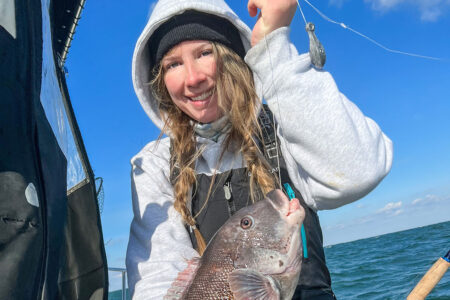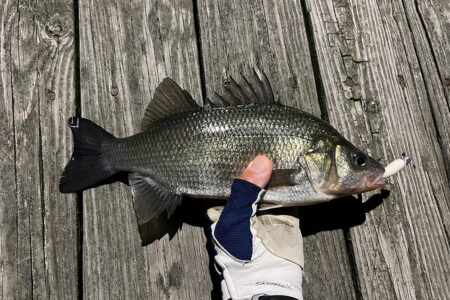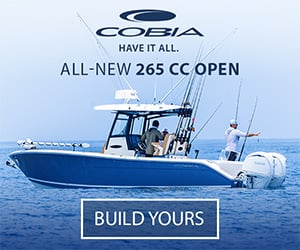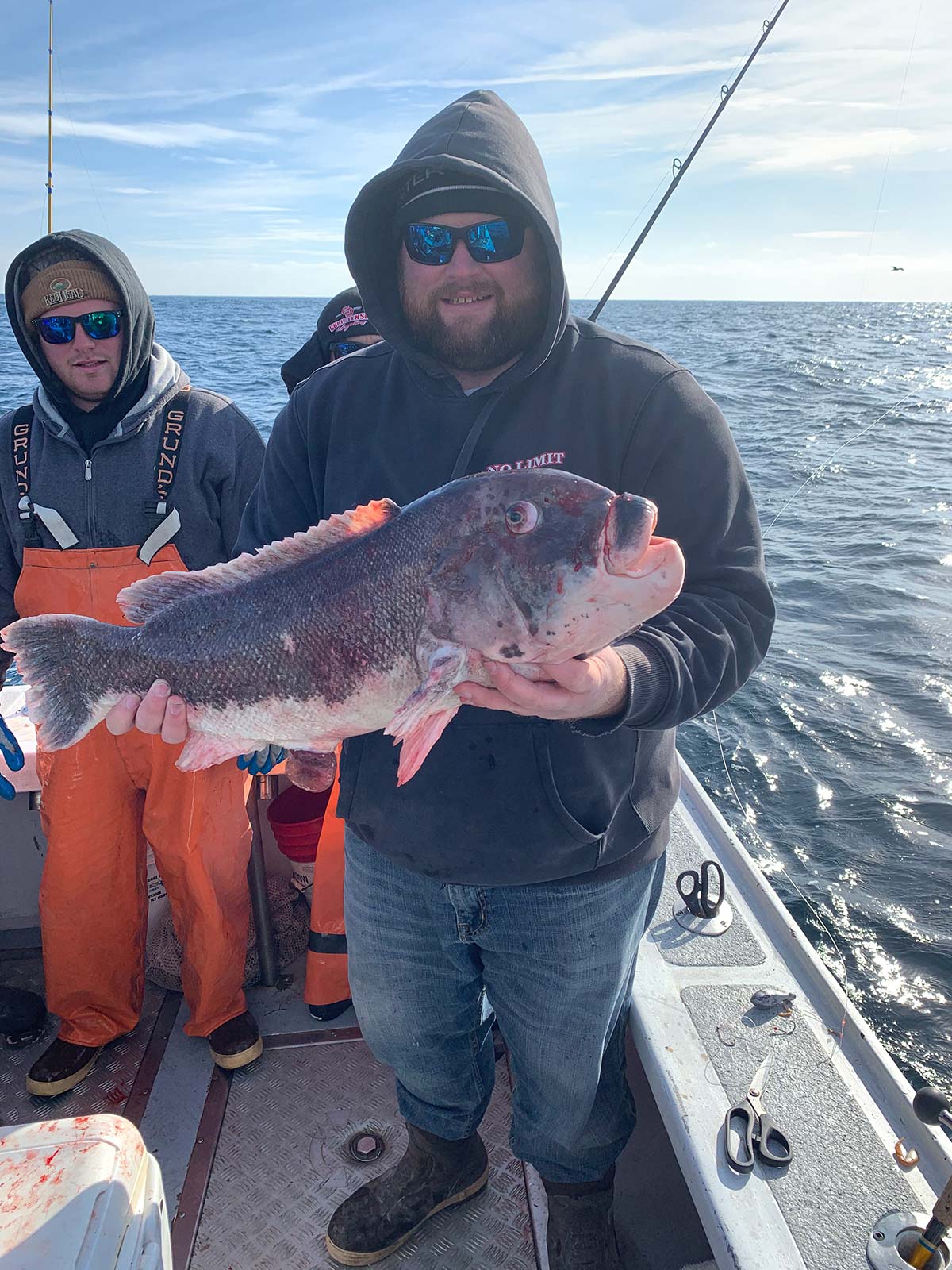
New Jersey’s tautog limit jumps to five fish at 15 inches on November 16.
In the 1980s, there were more blackfish around, and not nearly as many folks fishing for them. In New Jersey, I fished for blackfish mostly after Thanksgiving when the surf run of striped bass was beginning to slow down. A pool-winner in those day was perhaps 8 or so pounds. Green crabs were standard and all that I ever saw used at that time. I fished from late November until it got so cold that I just couldn’t anymore, usually after the New Year.
Here we are some 45 years later, and it’s all about hunting for jumbos! Those double-digit fish weighing over 10 pounds look much more common on Facebook than they are on the end of your hook, but if you fish the right way and use proven gear and rigging, the odds will lean toward you just a bit.
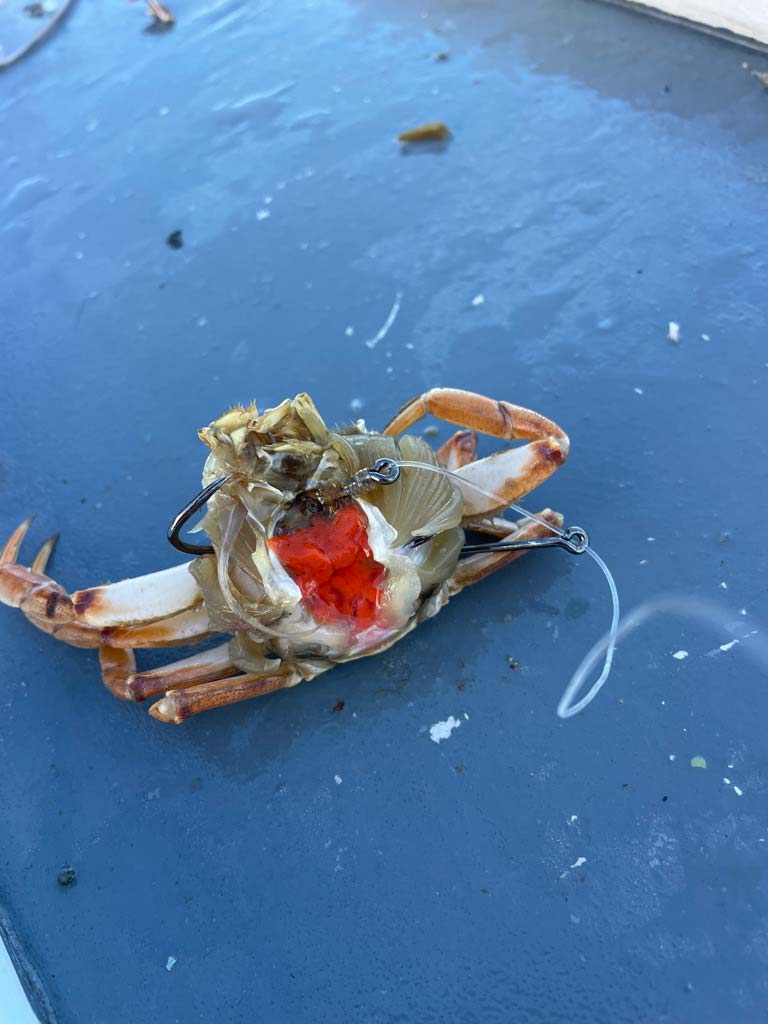
At Home & Abroad
We as fishermen have to make a choice of how to spend our time and money. Again, thanks to social media and a popular regional fishing magazine I know of, it has become common knowledge that large blackfish also live to our north and to our south. Many anglers travel to Rhode Island or Massachusetts in October and November for their tog season, though Delaware, Maryland and Virginia also see an excellent wintertime tog fishery with many big fish.
Fifteen years ago, these fisheries were known only to a very select group of locals, and an even smaller group of hard core toggers that traveled to these waters in search of big fish. Finding a captain in these locations with the skills and dedication needed to run a top tier tog boat was no easy task back then. The development of some excellent captains quickly blossomed into new business opportunities and a chance for the traveling fisherman to get in on this action. Wreck locations, knowledge of what conditions will make one location better than any other on this day, and captains’ innate skill and equipment will make certain boats stand head and shoulders above the rest. New Jersey boasts both excellent size of blackfish, as well as some of the very best blackfish captains along the entire Atlantic Coast.
The fall blackfish season at the Jersey Shore really gets going in mid-November and lasts until the end of February. It is closed in March, opens again in April the closes again until August the let the fish spawn and relieve some pressure. During that time, we have a blast catching these fish, but the thought of hunting for a jumbo requires planning years ahead for me!
September thru November finds average size fish in the back bay around bridges, sod banks, and bridges. By mid-November they will be pushing off into the reef sites to join their larger sized family members, where they will feed very well and many will spend the winter months here.
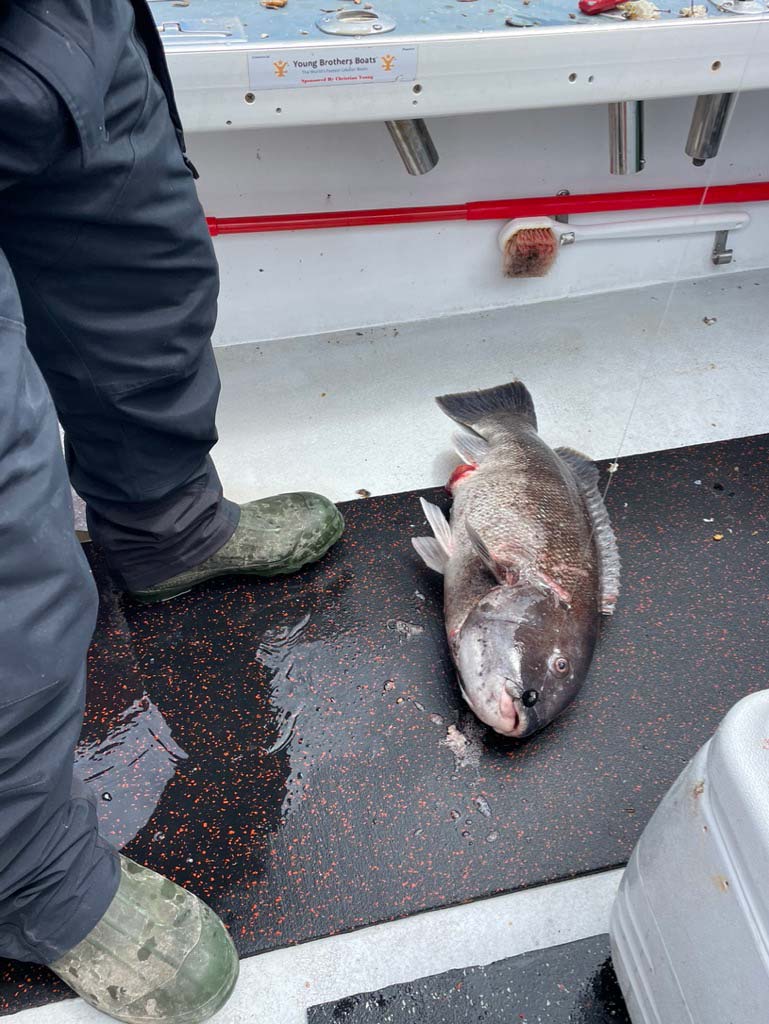
Ambush Strategies
Transitional zones are areas where the tog will pass through and set up home for a period of time. Inshore and nearshore spots are susceptible to changes such a huge influx of cold or rain water from inshore storms. Even the bite at the reef sites in 100 feet of water is sometimes affected when a huge storm roils the surf and that dirty water eventually pushes out and changes the normal conditions that these fish live in every day. Fish move around these reef sites as conditions dictate them to. For example, Wildwood Reef will often be very good during the fall, but the water temp drops a few degrees and that bite will die off, with Cape May Reef then getting good. Some of these transient fish move between sites as they are somewhat nearby, but offer different depth and current influxes.
Then we have the isolated offshore wrecks, often in 125 to 150 feet of water, where these fish are homebodies. The largest fish often live their entire adult life here on this wreck. They spawn here as well, when the conditions are right for them. The largest male blackfish will actually develop a “Bull and Harem” relationship with the other males and females as they live together. These fish spawn way out there offshore where they live, the female swimming toward the surface as the male is hot on her tail as they do their thing. Targeting and harvesting these fish is a very unique situation; if you can take your time wrestling one of these behemoths to the surface, and they don’t self-destruct during the fight, we try to let them go if you think that they will make it.
Fishing with the best captains who specialize in this fishery has shared some insane information with me. For instance, I might say “Hey Cap, how come you keep the boat on this eastern side of this wreck?” to which the captain replies “this is an old clam boat. When she went down the dredge and clam cages were on the rear deck. Huge fish live in those cages.” What the skipper might explain is that if you were hook one you may never get him out of that cage, and being many miles from the next piece, when you bust him off and shut down the bite, we have to wait an hour until we are set up on the next spot!
Yes, huge fish live in this structure; knowing the spot within a spot is the difference between having a chance and a very tough day.
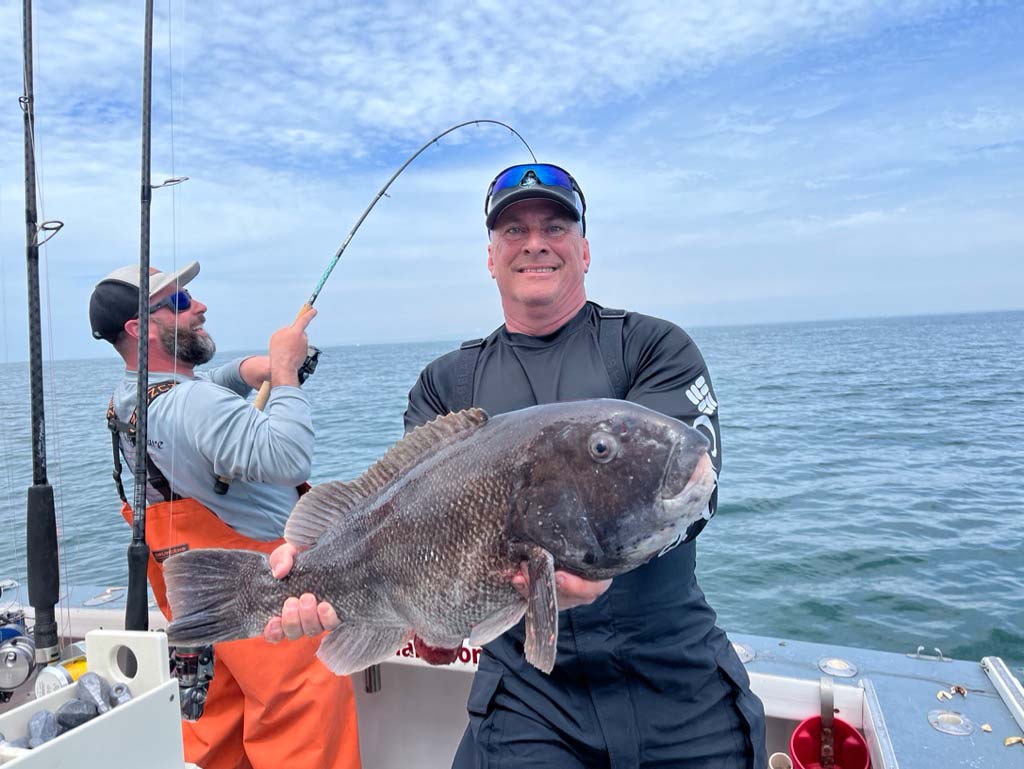
All Geared Up
Inshore I am more apt to fish with a jig than I am offshore. Usually if I am in water deeper than 100 feet, I feel under-gunned with the jig gear. Depending on which side of the boat I am fishing, the direction of the current and where the jig settles on the bottom, a jig baited with a small whitelegger will just get smoked! Just keep in mind that if the boat is tight on the anchor lines from waves and wind on the surface, there may also be a strong bottom current coming from either the port or starboard side flowing towards the other side.
That said, if I am fishing a jig from the starboard side and I drop my jig to the bottom, the bottom current will sweep my jig toward the rigs of the fishermen on the port side of the boat. In this scenario, I would rather fish a rig with a 10-ounce weight on the starboard side. On the other hand, if I were fishing on the port side of the boat the current flow is excellent for fishing a jig! Keeping your line tight and minimal moving of your jig will prevent you for snagging on the bottom. This is why jiggers prefer the stern corners on smaller charter boats. On large head boats position is much less of an issue because you can easily move spots on deck.
Using the right gear is critical here. A 4,000 size reel with 20-pound braid is a great choice. A length of 40-pound fluorocarbon leader tied to a 1- to 2-ounce Magictails blackfish jig won’t let you down. My rod is an almost 8-foot-long Century Weapon Mag Taper; it may not look it, but this rod has beastly power in a super lightweight package. I’ve seen this rod pluck a tog just under 18 pounds and it wasn’t a struggle, not even a little bit. This rod is capable of landing a record fish.
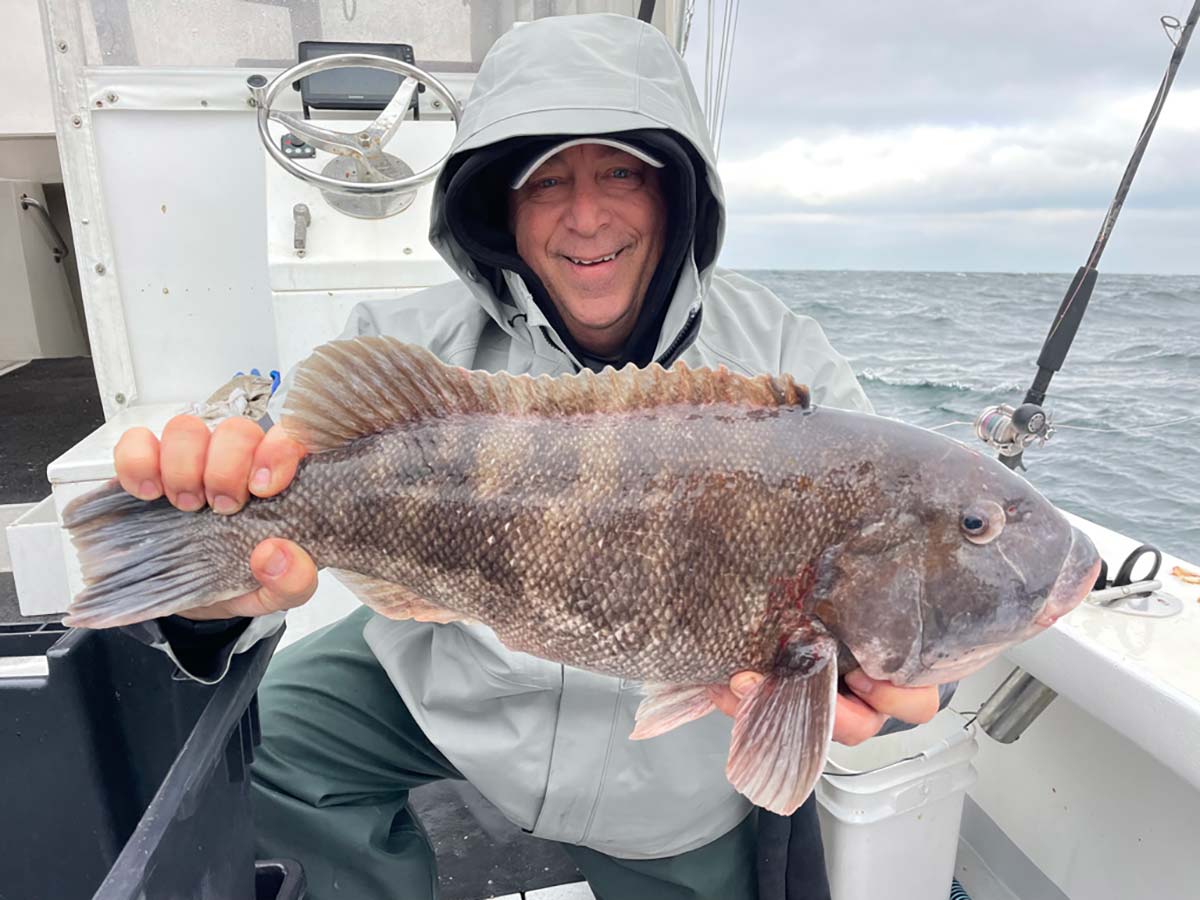
While fishing the side of the boat with the current going under the boat, this is when U will be fishing my conventional outfit. There are many rods out there, some better than others. Fishing a 10-ounce weight and a crab all day long is a lot to ask of a rod, but how does it balance in your hands? Is it both light and powerful? Can it help you land the one fish that you’ve secretly hoped? My rod of choice is a factory-built Century ProTogger with an aging Daiwa Saltiga 15 boasting a 5.1:1 gear ratio which is mission critical; too tall of a gear lacks the needed power. The Saltiga in this gear ratio is now discontinued. A Shimano Ocea Jigger is an excellent substitute in the correct gear ratio.
| HOLIDAY PARTY |
| Usually around Christmas we will begin pushing off farther from shore to fish the offshore wrecks and reef sites which holds more oversized tog that the inshore structure does. They are harder to fish of course, and weather is always the deciding factor. That’s where turning to the pros is the best advice I can offer; I have charters scheduled already with captains who specialize in this type of fishing. They know the spots and they have the correct boat. So, I get the call the evening before around dinner time and the weather window allows us to run far, then my crew and I decide to pay a little extra and take a chance to go big!
The core group of guys on my trips are dedicated gentlemen; We don’t make plans with our wives the night before a charter, and the day of charter we will be asleep before our head hits the pillow, so we say yes to the long day and we have no regrets if we see our friend catch his new personal best tog! God willing, maybe there’s one waiting for us as well! F. Mihalic |
Line-wise, 50-pound Daiwa JBraid 8 is my favorite with a Yucatán Knot connecting my 20-foot stretch of Ande Pink 60-pound top shot. The Yucatán is super quick and easy to tie and brutally strong. My rig is tied into my top shot via a Belmar rig. I prefer to use a slider rig when inshore, but offshore I like a snafu rig unless there is a lot of bottom current. If they won’t eat it the right way I’ll use a single hook rig. On the business end, 5/0 Owner Octopus hooks have never let me down. My favorite leader is 60-pound test Tsunami Pro Fluorocarbon leader material which has a very hard finish and snugs down without getting distorted.
Crab size determines how I will fish a rig. A snafu rig has two leaders and two hooks. I prefer to remove the claws and put a hook in each hole and fish the crab whole. The slider rigs works great when I take the top shell off of a smaller crab. The hooks hold the bait sideways and the hookup ratio is improved.
I hope to see you all on a boat or on the docks this month and into the New Year. Best of luck to you and I hope you catch that jumbo this season!


